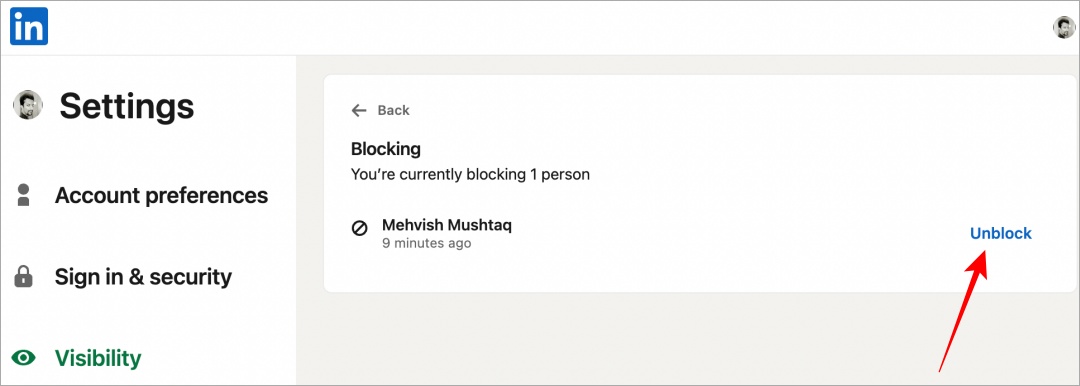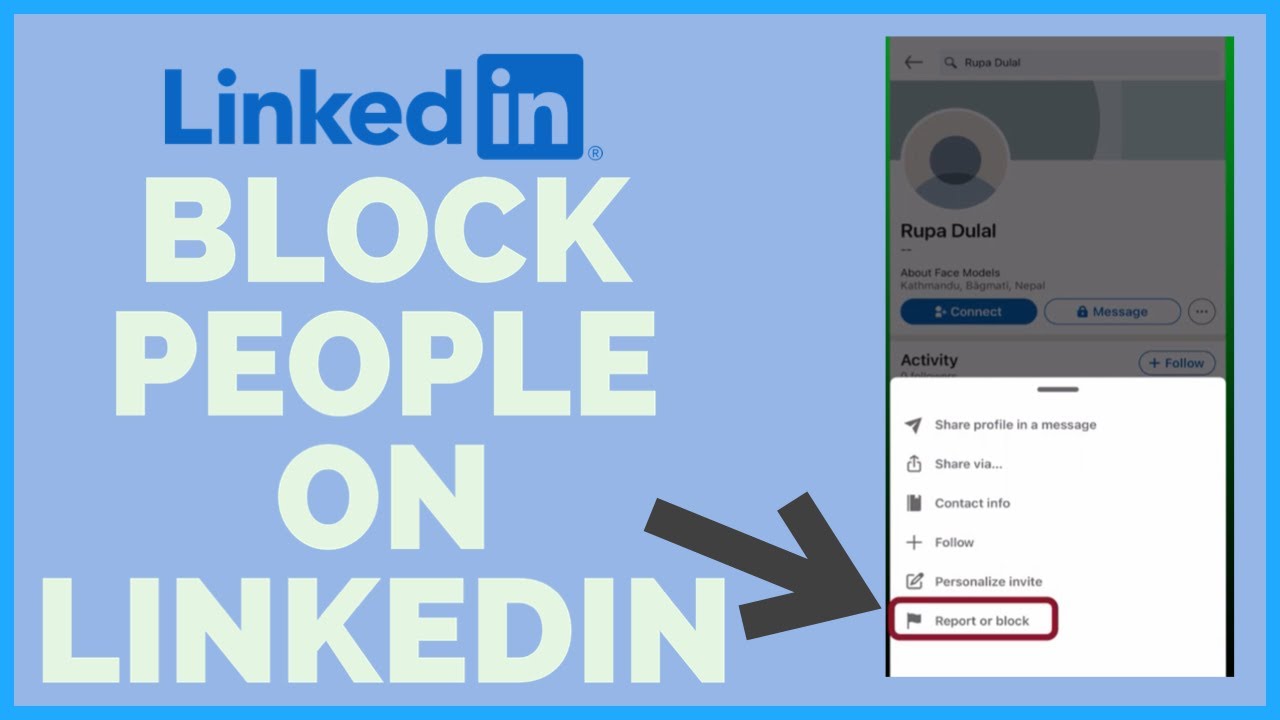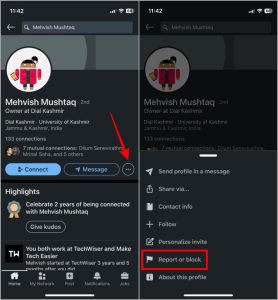LinkedIn, the professional networking platform, provides users with various tools to curate their connections and maintain a safe browsing experience. One such feature is the blocking option. But what does it really mean to block someone on LinkedIn? Whether you’ve encountered spam, harassment, or simply want to cut ties with a connection, understanding the blocking features can empower you to navigate LinkedIn more confidently. In this post, we’ll delve into the mechanics of blocking someone and what it entails for both you and the person you block.
How Blocking Works on LinkedIn

Blocking someone on LinkedIn is a straightforward process, but it has significant implications for your connections and visibility on the platform. Here’s how it works:
- What Happens When You Block Someone: When you block a user, they can no longer see your profile, send you messages, or view your activity. It’s as if you no longer exist to them on LinkedIn. This feature is particularly useful if you want to keep your professional life free from unwanted interactions.
- Privacy Settings: Blocking someone enhances your privacy. Your profile becomes invisible to the blocked user, and vice versa. It’s a way to assert control over who can access your professional information.
- Notifications: The person you block will not receive any notification that they’ve been blocked. This means you can sever ties discreetly, without causing potential awkwardness or tension.
Here’s a simple overview of what changes occur once you block someone:
| Action | Effect |
|---|---|
| View Profile | Blocked user cannot view your profile |
| Send Messages | Blocked user cannot send you messages |
| View Connections | Blocked user cannot see your connections |
| See Your Activity | Blocked user cannot see your posts or updates |
It's also worth noting that blocking someone on LinkedIn does not automatically remove them from your connections. If they are a first-degree connection, you must unconnect with them separately. This dual-step process allows you to decide how you want to end the relationship, whether completely or just through blocking.
Lastly, if you change your mind, you can unblock someone later. However, keep in mind that when you unblock them, you will not automatically re-connect—you’ll have to send a new connection request. This is important to remember if the relationship might be revisited in the future.
In conclusion, blocking someone on LinkedIn is a valuable tool for users who wish to maintain control over their professional interactions. By understanding how blocking works, you can navigate the platform with greater assurance and comfort.
Also Read This: How to Find a LinkedIn Profile’s Email Address: A Quick Guide
What the Blocked User Can Still See

When you block someone on LinkedIn, it’s important to understand that the blocked user still retains a certain level of visibility regarding your profile, but it’s quite limited. Here’s what they can still see:
- Your Public Profile: If the blocked user has searched for your name or profile on the internet (outside of LinkedIn), they may be able to see your public profile, depending on your privacy settings.
- Previous Interactions: Any messages exchanged via LinkedIn Messenger prior to blocking can still be accessed by the blocked user. This includes conversations in both personal and group chats.
- Group Memberships: If you and the blocked user are both members of the same LinkedIn group, they can still see your contributions to that group. Your posts, comments, and interactions there will remain visible to them.
- Your Activity on Shared Content: If you ever commented on a post or shared content visible to the public or within a group where they are a member, they might still see your activity. This means that while they cannot view your profile, they could potentially interact with your digital footprints elsewhere on the platform.
These aspects can feel a bit intrusive, especially if the reason for blocking someone was due to discomfort or conflict. However, the primary point of blocking is to limit direct contact and visibility, not to erase every trace of your connection or participation on the site. Keep in mind that their ability to view certain information depends significantly on your privacy settings, so you might want to review those if you're concerned about what is still out there.
Also Read This: Effective Ways to Request a Referral on LinkedIn for Job Applications
What Happens to Connection Status After Blocking

One of the most critical aspects of blocking someone on LinkedIn is how it impacts your connection status with that individual. Here’s what you need to know:
- You Are Unconnected: When you block someone, LinkedIn automatically disconnects you from that individual. This means you won't appear in each other’s connections anymore—it's effectively like hitting the 'unfriend' button on social media platforms.
- Reconnection Issues: The blocked individual cannot send you a connection request unless you unblock them first. If they want to reconnect, they’ll have to wait until you lift the block.
- Impact on Endorsements and Recommendations: If you had given or received endorsements or recommendations from the blocked user, those will be removed as well. This might affect your profile’s appeal, especially if you relied on their endorsement to bolster your professional standing.
- Messages Remaining: Any prior messages exchanged remain in the LinkedIn messaging platform. You can view these messages, but the blocked user won’t have the same access to your account anymore.
Blocking someone is a clear signal to draw a boundary in your professional networking, and LinkedIn facilitates that by severing the connection entirely. It’s a useful tool for maintaining your online presence in a way that’s comfortable and secure for you. If you ever change your mind about a blocked user, it’s as simple as going back into your settings and unblocking them. Keep in mind, however, that this action won’t reinstate any previous endorsements or messages automatically; it will be like starting fresh again!
Also Read This: How to Create a Post Like a LinkedIn Influencer: Tips for Maximum Impact
5. Notifications and Privacy Settings
When you decide to block someone on LinkedIn, it's not just a simple click of a button; there are several layers to consider regarding notifications and your privacy settings. After all, LinkedIn is a professional networking platform, and how you manage your connections—or lack thereof—can affect your professional image.
First and foremost, when you block someone, they won’t receive any direct notification that you’ve blocked them. However, they might notice a change if they attempt to view your profile or interact with you. Your profile will become invisible to them, and previously shared connections or interactions will no longer be accessible. This absence can often raise eyebrows if that person is astute in monitoring their network activity.
On the other hand, it’s important to understand how this can impact your own privacy. LinkedIn allows you to adjust your privacy settings for who can see your activity. For instance, if you’re concerned about certain individuals knowing every time you update your profile or make connections, you can modify these settings. Tightening your privacy settings can help create a more comfortable environment for networking without unwanted scrutiny.
Here are some key points regarding notifications and privacy settings when blocking someone:
- No Notification: The person you block won’t get an alert, but they may realize something is amiss.
- Profile Visibility: After blocking, your profile becomes invisible to them.
- Adjust Privacy Settings: You can manage who sees your activity and profile updates.
- Same Network Implications: If you’re part of the same group or network, they can still see your contributions within those spaces.
Being aware of your actions and their consequences can help you maintain a level of professionalism while still ensuring your comfort and safety on the platform. So, take a moment to review your privacy settings to better align your network with your career goals.
Also Read This: How to Update LinkedIn Profile: A Guide to Keeping Your Profile Current and Optimized
6. How to Block Someone on LinkedIn
If you're in a situation where blocking someone on LinkedIn seems to be the best option, don’t worry! The process is quite straightforward. Here’s a step-by-step guide to help you through it:
- Navigate to Their Profile: Start by finding the profile of the person you wish to block. You can do this by using the search bar at the top of the LinkedIn homepage.
- Click on the "More" Button: Once you’re on their profile, locate the “More” button, which is usually found right next to the “Connect” button.
- Select "Report/Block": Click on "More," and a dropdown menu will appear. From this menu, choose the “Report/Block” option.
- Choose "Block": A pop-up will appear with options. Select “Block [Name].”
- Confirm Your Decision: LinkedIn will ask you to confirm that you want to block this user. This is your chance to double-check if you’re blocking the right person before proceeding.
- Done! Once confirmed, the user will be blocked, and you won’t see their profile or activity in your feed.
It’s as simple as that! Just remember, blocking someone is a significant step, so ensure it’s truly what you want to do. If you’re ever in doubt, you can also consider reaching out to the person directly to address any issues that might be leading you to consider blocking them.
In conclusion, managing connections on LinkedIn is crucial for maintaining a healthy professional network. Understanding how to use the block feature effectively can enhance your experience on the platform while ensuring you control your visibility and privacy.
Also Read This: How to Add Honors and Awards on LinkedIn? Showcasing Your Achievements on Your LinkedIn Profile
7. What to Consider Before Blocking Someone
Deciding to block someone on LinkedIn is not a choice to be made lightly. Before hitting that block button, there are several important factors you should consider. It’s crucial to evaluate the situation holistically to ensure that you’re making the best decision for your professional image and network.
1. Nature of Your Relationship
Think about your relationship with the person you’re considering blocking. Did you have a conflict that’s unlikely to resolve? Or is it a matter of differing opinions on professional matters? Understanding the history can help guide your choice. If the relationship is more adversarial than collaborative, blocking might be a valid option.
2. Impact on Your Network
Consider how blocking this individual could affect your network. Sometimes, connections can be valuable even if the individual isn’t very pleasant. If they know important contacts or can provide insights into your industry, think about whether the benefits of keeping them in your network outweigh the negatives.
3. Purpose of Blocking
What are you hoping to achieve by blocking? If your goal is to reduce negative interactions or escape harassment, it’s a strong reason to take action. However, if it’s based on a moment of frustration, consider whether it’s worth it in a professional context.
4. Alternatives
Sometimes, blocking isn’t the only solution. Consider other options, such as adjusting your privacy settings or restricting their visibility to your posts. You can even mute them if their updates are bothering you but you don’t want to sever the connection.
5. Future Consequences
Blocking someone on LinkedIn doesn’t just affect the immediate interaction; it may have long-term consequences. They may view it as a professional slight, which could sour your relationship “in the field.” Think, “Will this decision backfire later?”
Taking the time to evaluate these considerations can help you stay more intentional about how you manage your LinkedIn network. Discussing the decision with a trusted colleague or mentor can also provide a fresh perspective.
Also Read This: How to Add Clickable Links to LinkedIn Posts for Better Engagement
8. Alternatives to Blocking on LinkedIn
If you’re hesitant about blocking someone on LinkedIn (and let’s face it, not everyone wants to take that step), there are a few alternatives you can explore. These options may help manage your interactions more gracefully while maintaining the integrity of your professional presence.
1. Adjusting Privacy Settings
One of the simplest approaches is to tweak your privacy settings. For instance, you can control who sees your posts and activity. By setting your account to private, you limit visibility to only those in your network, reducing unwanted interactions without severing ties.
2. Muting Connections
If you find certain posts or updates from a connection annoying but don’t want to take it to the level of blocking, consider muting them. This will allow you to stay connected without having their updates clutter your feed. They won’t be notified of the mute, so there’s no awkwardness involved!
3. Restricting Message Access
You might also want to restrict your connections' ability to message you. While this is a more drastic measure, it can protect your peace if the messages are consistently negative or overwhelming.
4. Setting Boundaries
Sometimes, simply reaching out and setting boundaries can work wonders. If you feel comfortable, consider messaging the person to express your feelings about their behavior. A well-crafted message can sometimes clear the air without needing to block anyone.
5. Reporting Inappropriate Behavior
If you’re facing harassment or inappropriate messages, don’t hesitate to report them to LinkedIn. The platform has policies aimed at protecting users and addressing such behaviors appropriately. Reporting allows you to keep your workspace professional without resorting to blocking.
In the end, blocking isn’t your only option. Evaluate your situation and consider these alternatives. By doing so, you can maintain a professional environment while addressing any concerns you have regarding your connections. Finding balance is key, and there are always ways to move forward without burning bridges.
Conclusion: Making Informed Decisions on LinkedIn
Connecting with professionals on LinkedIn can open many doors, but knowing when to block someone is equally essential for maintaining a positive experience on the platform. Blocking is a powerful tool but one that should be used cautiously and thoughtfully. Here are some key points to consider:
- Assess Your Connections: Regularly review your connections. If someone is no longer relevant to your professional network, consider their value before blocking.
- Understand the Consequences: Remember that blocking someone removes them from your network entirely. This action may affect future collaboration opportunities.
- Maintain Professionalism: Always aim to handle conflicts with professionalism. If a situation escalates, a direct message may resolve it without necessitating a block.
- Privacy Considerations: Understand that blocking someone preserves your privacy. They won't see your profile, posts, or any updates.
When evaluating whether to block a connection, consider factors such as professional reputation, mutual connections, and the possibility of future interactions. If blocking is necessary to protect your peace and networking goals, take that step confidently.
In conclusion, making informed decisions on LinkedIn about blocking should be based on careful consideration of your professional landscape and personal comfort. Trust your instincts, and prioritize your mental well-being as you navigate the complexities of online networking.
 admin
admin








